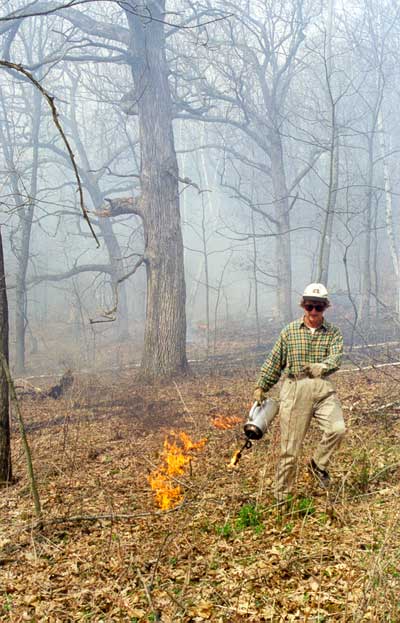Bur oaks, tallgrass prairie, and fire
The bur oak (Quercus
macrocarpa) is a common species associated with the oak savanna landscape.
This species is also known to “invade” prairies, where it can, under
appropriate conditions, become established. Bur oaks and prairies thus “go
together”.
Fire is an important element in controlling the relationship
between oak savannas and prairies. The bur oak is the most fire-resistant of
the oaks. Even fairly small bur oak trees produce a fire-resistant, corky, bark.
Depending on the intensity, such “grubs” can often “escape” fire. Once
they get large enough, their fire resistance is so great that they can even
tolerate relatively intense fires.
At Pleasant Valley Conservancy, the south-facing slope
provides an interesting habitat for observing prairie/bur oak relationships.
The upper part of the slope is an extensive bur oak savanna with many mature trees
that have survived numerous fires during their lengthy existence. The lower
slope is primarily tallgrass prairie, but is continually being “inoculated”
from above by bur oak acorns.
 |
| Grove of mature bur oaks on the upper part of the south slope |
When we first started restoration work at PVC, the south
slope was quite wooded, with invasive shrubs and trees, including pines and red
cedars. The prairie patches were small and scattered. After the slope was cleared of woody vegetation, the first burns we
carried out were very poor. There
was insufficient fuel to carry a fire, so we had to “force” it to burn by
extensive use of the drip torch. Although the bur oaks were being heavily
crowded by the invasive woody plants, they were still able to function because
their canopies were above everything else. And because of the unsatisfactory
fuel, flame heights were low and had little effect on the oaks.
In order to bring this ecosystem back to its full potential,
beginning in 1998 we initiated a program of annual burning. For the first few
years, with the poor fuel, burns were unsatisfactory, and we had to use
headfires, lighting at the bottom of the hill and hoping the flames would carry
to the top.
Gradually, the burns got better. It was in 2003 that the
headfire, lighted at the bottom, carried to the top of the hill. (Because of the steep slope, a fire lighted from the bottom of the hill acts as
a headfire even is there is no wind.) Since 2006 we have only burned the south slope as a backing or flank
fire, starting at the top.
 |
| A bur oak grub seen in 2010. |
If the fire is hot, oak grubs are top-killed and then resprout later that season. This is SOP for oaks, and with annual burns they go through this cycle every year. Although their stems remain small, their root systems keep expanding, since the roots are not killed by the fire. (Soil is a very poor conductor of heat.)
This year (2017, see photo below) I discovered that some of these bur oaks
have gotten out of the grub stage, perhaps for the first time, and their bark
is now thick enough that the stems were not killed by the fire. I counted six
bur oaks large enough to perhaps survive our annual burns.
 |
| Six small oak trees, at least two of which are out of the "grub" stage. These are just at the top of the steep Pleasant Valley Road hill cut. The tree on the right is also seen in the fire photo below. |
As it happened, I got a photo of the burn moving across this
area. The yellow arrow on the photo points to the largest bur oak.
 |
| Low intensity fire moving across the south slope. The yellow arrow shows the location of the tree seen in the above photo. |
What does the future portend for these bur oak “trees”?
It seems likely that they will survive and thrive. Because they are at the
bottom of the hill, they would likely survive even a headfire, because it takes
some distance before the flame reaches its steady state height. However, due to competition, eventually there should be only one rather substantial tree, since the largest should
eventually get big enough to shade out the rest. (Bur oaks are very shade
intolerant.)
We already have examples of this further along the south
slope, where there are scattered small bur oak “trees”. Walk along Pleasant Valley
Road and take a look.
Does this mean that our tallgrass prairie will eventually
turn into a bur oak savanna? Perhaps, although perhaps it will turn into what
Steve Packard calls a “tallgrass savanna.”
Only time will tell. (The bur oaks are long-lived trees and have
plenty of time.)








